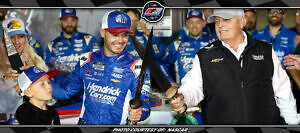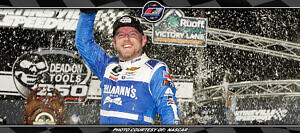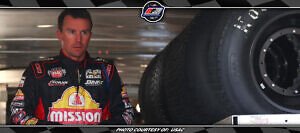
Column By: REID SPENCER / NASCAR – KANSAS CITY, KS – Move over, Ricky Craven. Move over, Jimmie Johnson, and thank you, Bill Braniff.
On Sunday night, in a race that started more than three hours after its scheduled time because of rain, Kyle Larson erased the names of Craven and Johnson from the NASCAR Cup Series record book.
Larson’s winning margin of 0.001 seconds over Chris Buescher in the AdventHealth 400 at Kansas Speedway superseded the 0.002 advantages of Craven over Kurt Busch at Darlington in 2003 and Johnson over Clint Bowyer at Talladega in 2011.
The finish at Kansas was so close that NASCAR needed a high-definition image to determine that Larson’s No. 5 Hendrick Motorsports Chevrolet had reached the laser-generated stripe roughly one inch ahead of Buescher’s No. 17 Roush Fenway Keselowski Racing Ford.
Clearly buoyed by the rush of the photo finish, an animated and atypically loquacious Larson took questions from reporters in the Kansas Speedway media center. The winning driver had nothing but praise for the 1.5-mile track, which has matured in spectacular fashion since a repaving and reconfiguration project in 2012.
In addition, the Next Gen car, introduced into the Cup Series in 2022, has proven the perfect vehicle for intermediate speedways, as was abundantly evident on Sunday night.
“I think, from my perspective, it’s got grip, but it’s got progressive banking, so you kind of move your angles around and stuff,” Larson said of Kansas Speedway. “The way this car is, you can get good drafts and all that.
“The leader is typically at a disadvantage I feel like on these mile-and-a-halfs, because it seems as though you abuse your right rear tire more, so it’s hard to get away. You’ve got the draft plus you’re abusing your tires more.
“So, it just keeps the field bunched up. I think with the old car, we’d probably get out to like an eight-second lead here. The couple-second lead that I got in the second stage was as big as you’d probably see in the Next Gen era on a mile-and-a-half.”
Without doubt, the finish of Sunday’s race will remain the focal point. Larson acknowledged that the event would remain one of his career highlights.
“I mean, I’ll always remember it, for sure,” he said. “I think there’s definitely wins that you can kind of get lost in the distance a little bit, but when you finish and have the closest, to this point, finish in Cup Series history, I don’t think you’re ever going to forget about it, even if it gets broken someday.
“Yeah, just great to be on this side of it. I probably would still remember it, though, if I ran second.”
It wasn’t just the finish, however, that made the AdventHealth 400 remarkable. The quality of racing in the first stage was an ideal to be envied and, if possible, duplicated. After the first cycle of green-flag pit stops, Larson battled Ross Chastain for the top spot, frequently swapping positions with the driver of the No. 1 Trackhouse Racing Chevrolet.
Denny Hamlin, Buescher and Ty Gibbs soon joined the party, and after the Stage 1 break, Buescher made a spectacular move up the middle that momentarily took the field five-wide. The unrelenting action made a lasting impression on the race winner.
“That was a blast, racing Ross,” Larson said. “I was battling him obviously really hard, but I was also at the same time trying to take care of my stuff the best that I could.
“I would pass him, he’d get a good run to get by back, and we were just kind of stuck racing each other. Then I finally got clear, and I was like, ‘OK, I’m going to be able to drive away,’ but I quickly built super loose and had a couple big moments, and it just brought the pack right back to me.
“I (saw) Denny was coming and tried to fight them off as long as I could. I think, gosh, there was probably five or six of us all kind of right there with 15 (laps) to go or so (in Stage 1), and, yeah, that was just incredible racing.”
The racing at Kansas wasn’t notable immediately after the repave, which created an extremely fast, one-groove race track. After 12 years of aging, however, the track has evolved into a multi-lane speedway replete with competitive options.
Kansas Speedway president Pat Warren popped into the media center’s deadline room after the race to make sure Bill Braniff got his due. In 2012, Braniff was senior director of construction for International Speedway Corporation and oversaw every aspect of the repaving process.
A dozen years after the fact, his expertise paid off in one of the most captivating races in recent memory—from green flag to checkers.







